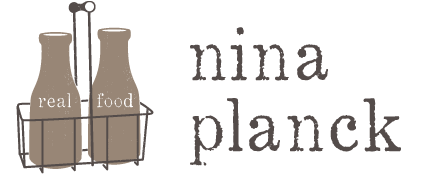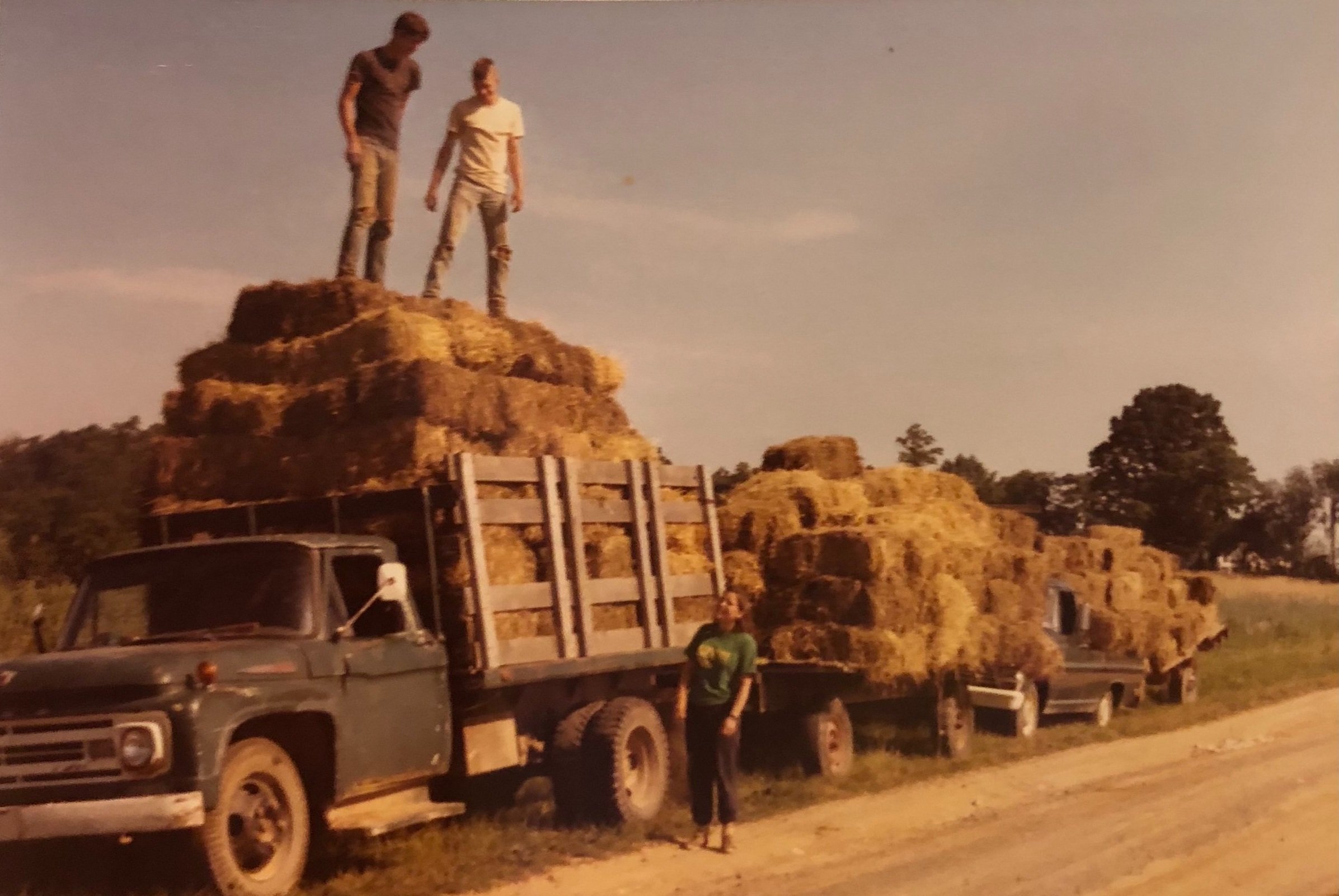On Poison Ivy and Mulch
July 24, 2024
Mulch Run: Charles Planck (white shirt) on the F250 with Holmes Graybeal and Tamara Wilson. Loudoun County, Virginia, 1984
It's late July, so in the garden, I hope to be doing only two things: weeding and watering. Planning done. Planting done. Then I hope to be sitting down with a lemon-rosemary shrub made by Patrick Lango of White Cow Dairy, in Buffalo.
If I were a vegetable farmer in July, however, I'd be picking and selling like mad. Watering too, but if I had much or really any weeding in July, I'd be in trouble. Weeds grow faster than bell peppers and this is the time to sell peppers, not weed them.
In our early years farming, the weeds were taller than me, we weeded all summer along, and every day was Hotter Than July - a great Stevie Wonder record, from 1980, our second year farming in Loudoun County, Virginia, among the weed forests. Our Wheatland pigweed, lambs quarters, and ragweed resembled small saplings but both have shallow roots, so if you set yourself properly and used your legs (not your back) you could pull them out. Pennsylvania smartweed (and what do they call it here in Pennsylvania and New Jersey, where I live now?) I loved for the tiny pink berries, but geez it's aggressive. Pokeberry and deadly nightshade I loved for the leaves and blossoms, and feared for their beautiful, dark, poisonous berries. Poison ivy tormented me on the regular, and still does, this week.
Speaking of poison ivy, do you know the Hot Water Treatment? “Poison Ivy, Lawd, will make you itch!” as The Coasters sang, because the blisters are full of histamines dying to escape the prison of your skin. (That's why you might take an over-the-counter "anti-histamine.") So you rub, scratch, maybe tear, and out they come. Ahhh. But if you tear your skin, it's not so nice. Another way to let out the histamines is by applying hot water. Very hot water. It must be applied directly to the skin, ideally by submersion, just short of scalding the skin. So if it's on your hand, dip it in a sink or a bowl. If it's on your ankles and legs, put four inches of water in the tub and ease on in. The more skin touched by very hot water, and the longer, the greater the release of histamines.
This treatment, done properly, will relieve itching for 6-8 hours. My mother taught me this method and I have used it for nigh-on 50 years, including this week.
You can apply heat in other ways. I have used a soaked wash cloth, a hair dryer, a hot pick-up truck (dark colors are better) and a wooden canoe, painted dark green, heated by the Vermont sun at my kid's camp. But nothing beats submersion in hot water, for as many seconds as you can stand it, and if you are very quiet for a moment, you get a little high in the head as the histamines come flowing out - without breaking the skin.
But back to weeding. After a few weedy years (and my brother has written eloquently on fighting the aggressive rhizomous Johnson grass), my parents discovered: landscape fabric (to plant the tomatoes in) and mulch (to cover the aisles) and we pretty much never hoed another 1/4 mile long row of pumpkins or hand-weeded any Earliglow strawberries. Which felt just about as good as releasing antihistamines.
Mulch? It's a little scratchy to carry and to put down. But it's heaven to walk on. To learn why Chip and Susan Planck love mulch, read on:
COUNTING THE WAYS
A paean to mulch.
By Chip Planck
On about 20 of our 25 acres of cropped land, we roll out 4 to 6 inches of hay mulch, between rows of plastic or bare ground beds. We use 4-foot wide round bales, weighing 500 to 700 pounds. Wider ones don’t fit the aisles of our 6 -foot center beds; heavier ones can’t be rolled out by one person.
These bales of less-than-prime quality hay cost from 10 to 12 dollars each, delivered. While some agrarian thinkers champion generating all inputs from one’s own land, we enjoy the symbiotic relationship of taking hay off the hands of local landowners. They get the land-use tax break for keeping their ground open, we get to grow more vegetables. Moreover, since those doing the baling are typically custom operators, charging landowners for their services and us for the bales, additional actors in the agricultural economy win.
By covering almost all our ground almost all the time, we have eliminated much hand hoeing and tractor cultivation of weeds. In the fall, we use a $1500 mulch lifter on a 50 hp tractor to undercut the plastic mulch. After picking it up by hand, we do a heavy disking of the crop trash and organic mulch, spread cover crop seed with a tractor-mounted fertilizer spinner, and cover lightly with trail-type disks set straight. So rough-surfaced are the fields of partly tilled-in mulch that they stay blanketed into the winter, too, resisting erosion, while the cover crops begin their slow growth.
Does the heavy annual application of hay mulch for 25 years cause a build-up of grass seeds? Not in our experience. If our farm’s weed problem were grasses, one might indeed suspect the hay. On the contrary, ground left bare is invariably clotted with broad leaf annuals, and I’m convinced these problems go back to the two red root pigweeds we let go to seed in 1987.
If we are storing bales over the winter, we accept only net wrapped, which shed water better. If using the same season, twine is fine. We move them around two at a time with pickup trucks, or singly with a tractor and rear-mounted bale spike. (We also use conventional square bales of straw in asparagus, strawberries, garlic, and rhubarb, and sawdust on blueberries.) Our round bale mulching costs about $6,000 a year, or $200 per acre, excluding labor, providing a rich range of aims and benefits.
Reasons, in random order. Admirers don’t rank attributes.
1. To suppress weeds.
2. To prevent evaporation of rain and irrigation water.
3. To add organic matter.
4. To promote microbial life in the top layer of the soil by reducing tillage and preventing its baking and drying. (“Bare soil is soil in agony.”)
5. To prevent run-off erosion by absorbing water and breaking its flow.
6. To prevent wind erosion by protecting the soil crumbs from dis-aggregation under the impact of rain drops, which leaves the ground in a dusty, blowable state once it dries out.
7. To prevent the transmission of soil-borne disease by the splashing of muddy water on foliage and fruits.
8. To give the fruit a clean, soft place to lie.
9. To give pickers a soft place to kneel.
10. To buffer the soil from compaction by machinery or footprints in wet conditions.
11. To provide a more diverse insect and spider habitat than bare ground.
12. To make the farm beautiful.
13. To build morale and cultural identity:
Wheatland Vegetable Farms (farmed by Chip and Susan Planck from 1979-2010) was known by other ecological farmers in the Washington, D.C. area as the “mulch farm.” At one yearly talent show (with potluck) a skit depicted Mulching in the Middle Ages, Enlightenment, Modern Times. Summer farm worker Zach Tobias invented a universal hand sign for mulching. This gesture can break the conversational ice in agrarian villages the world over.
Adapted from Sky Blue Trades, by Chip Planck. © 2024

